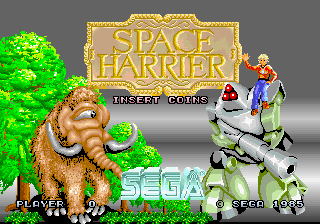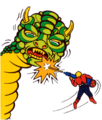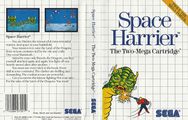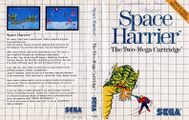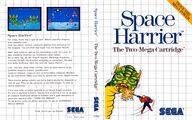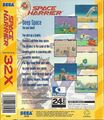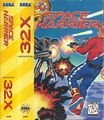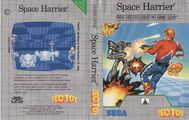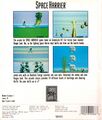Difference between revisions of "Space Harrier"
From Sega Retro
m (→Physical Scans) |
(→Legacy) |
||
| (One intermediate revision by the same user not shown) | |||
| Line 94: | Line 94: | ||
==History== | ==History== | ||
| + | ===Development=== | ||
| + | According to Yu Suzuki, the "original plan was supposed to be the military plane Harrier but "there was not enough memory space for the graphics so we changed the format to science fiction." He also noted that, because there "were no successful 3D shooting games before ''Space Harrier''", when he "submitted this idea, the 3D shooting genre was still taboo because the enemies were too small to hit." This was the case in Sega's earlier rail shooters ''[[SubRoc-3D]]'' and ''[[Buck Rogers: Planet of Zoom]]'' which saw limited success in arcades, while tube shooters such as ''Tempest'' and ''[[wikipedia:Gyruss|Gyruss]]'' avoided the problem by restricting movement and aiming. According to Suzuki, in order to "solve this problem, we added the homing missile system like a real fighter aircraft and made it into an easy to hit shooting system.” <small>(''Retro Gamer'', {{num|145|page=22}})</small> The decision to use an analog joystick over a digital joystick was because Suzuki felt it was better suited for a flying game and it gave the player greater control over pointing and shooting. <small>(''Retro Gamer'', {{num|145|page=27}})</small> | ||
| + | |||
| + | Suzuki wanted to keep the game's appearance family-friendly. He said the game's fantasy world was largely a homage to the artist Roger Dean and the 1984 fantasy film ''Neverending Story''. The game also references the ''[[wikipedia:Gundam|Gundam]]'' anime series with its robotic Dom enemies. Due to its limited production time, the game's six bosses were created within three months, a distinctive boss every two weeks. Each boss was made up of at least eight or more sprites, which move in sequence. The game makes use of repeated sprites moving at high speed, as a way around technical memory limitations. <small>(''Retro Gamer'', {{num|145|page=24}})</small> | ||
| + | |||
===Commercial Performance=== | ===Commercial Performance=== | ||
It became one of 1986's major chart hits in the arcades.{{ref|http://www.solvalou.com/subpage/arcade_reviews/103/320/space_harrier_review.html}} | It became one of 1986's major chart hits in the arcades.{{ref|http://www.solvalou.com/subpage/arcade_reviews/103/320/space_harrier_review.html}} | ||
| Line 105: | Line 110: | ||
The game was included as a minigame in both ''[[Shenmue]]'' and ''[[Shenmue II]]'', and more recently the Master System version of the game was made available via the [[Wii]]'s [[Virtual Console]] service in 2008, followed by a Virtual Console Arcade release a year later. It has also appeared on the [[Nintendo 3DS]] as ''[[3D Space Harrier]]''. | The game was included as a minigame in both ''[[Shenmue]]'' and ''[[Shenmue II]]'', and more recently the Master System version of the game was made available via the [[Wii]]'s [[Virtual Console]] service in 2008, followed by a Virtual Console Arcade release a year later. It has also appeared on the [[Nintendo 3DS]] as ''[[3D Space Harrier]]''. | ||
| + | |||
| + | The game's basic homing missile mechanic was the basis for, and was superseded by, the lock-on system of Yu Suzuki's 1987 title ''[[After Burner]]'', which was then adopted by later rail shooters such as Sega's ''[[Panzer Dragoon]]'' and ''[[Rez]]'' <small>(''Retro Gamer'', {{num|145|page=28}})</small>. [[Platinum Games]] designer [[wikipedia:Hideki Kamiya|Hideki Kamiya]], in a 2008 Facebook post, cited ''Space Harrier'' as one of his favourite video games of all time and an influence on his career. [https://www.facebook.com/note.php?note_id=9380283311] | ||
==Critical Reception== | ==Critical Reception== | ||
Revision as of 13:47, 30 September 2015
- For home computer conversions, see Space Harrier (Elite Systems) and Space Harrier (Dempa).
- For 3D home console conversions, see Space Harrier 3D (Master System) and 3D Space Harrier (3DS).
| Space Harrier | ||||||||||||||||||||||||||||||||||||||||||||
|---|---|---|---|---|---|---|---|---|---|---|---|---|---|---|---|---|---|---|---|---|---|---|---|---|---|---|---|---|---|---|---|---|---|---|---|---|---|---|---|---|---|---|---|---|
| System(s): Sega Hang-On hardware, Sega 32X, Sega Master System, Sega Game Gear, Nintendo Famicom, TurboGrafx-16, Virtual Console, Android | ||||||||||||||||||||||||||||||||||||||||||||
| Publisher: Sega, Takara, NEC | ||||||||||||||||||||||||||||||||||||||||||||
| Developer: Sega AM2, Sega, White Board | ||||||||||||||||||||||||||||||||||||||||||||
| Genre: Shooter / Shoot-'em-Up | ||||||||||||||||||||||||||||||||||||||||||||
| ||||||||||||||||||||||||||||||||||||||||||||
|
CERO
Missing Parameter! |
Space Harrier (スペースハリアー) is a third-person rail shooter / shoot 'em up game developed by Yu Suzuki and Sega AM2 which makes use of Super Scaler technology. It is one of many A-list arcade games developed by Sega during the 1980s, placing Sega firmly on the map and inspiring numerous sequels, starting with Space Harrier 3D.
Space Harrier and its sequels are set in the "Fantasy Zone", the same setting as the arcade game with the same name. This relationship was explored further with the Sharp X68000 port of Fantasy Zone, which includes a Space Harrier level, and the cancelled TurboGrafx-16 title Space Fantasy Zone, which was a hybrid between the two games.
The game spawned the sequels Space Harrier II (1988) and Planet Harriers (2000).
Contents
Overview
Using Sega's "Super Scaler" technology, the game produced pseudo-3D sprite-scaling at high frame rates, with the ability to scale as many as 32,000 sprites and fill a moving landscape with them, along with 6144 colors on screen out of a 98,304 color palette. It also introduced a true analog flight stick for movement, with the ability to register movement in any direction as well as measure the degree of push, which could move the player character at different speeds depending on how far the stick is pushed in a certain direction. The game was also an early example of a third-person shooter; it was influenced by Buck Rogers: Planet of Zoom, and in turn influenced later 3D shooters such as Nintendo's Star Fox in 1993.
Running on the arcade system board previously used by Hang-On, the pseudo-3D sprite-scaling in the game was handled in a similar manner to textures in later texture-mapped polygonal 3D games of the 1990s. Yu Suzuki stated that his "designs were always 3D from the beginning. All the calculations in the system were 3D, even from Hang-On." and concluded "I calculated the position, scale, and zoom rate in 3D and converted it backwards to 2D. So I was always thinking in 3D".[1] The game's success established Suzuki as the leading arcade game designer at the time.[3]
Gameplay
In Space Harrier the player controls "the Harrier", a blond-haired man with a jetpack who travels across the Fantasy Zone shooting at enemies and objects. It is a third-person "on the rails" shooter, in which the Harrier is constantly travelling into the screen - the player can move horizontally and vertically, but has no control over the speed travelling forwards. Similar to Fantasy Zone, the Harrier can traverse either on-foot or in the air without issues. The objective of the game is simply to survive, the chances of which are increased by shooting down enemies and avoiding obstacles.
Space Harrier contains 18 levels, each with a boss at the end. The 5th and 12th levels, however, are bonus stages with no threats, in which the player rides a friendly dragon known as "Uriah" with the objective of destroying as much scenery as possible. The 18th level, similar again to Fantasy Zone, is a boss rush, where the Harrier needs to defeat all the bosses he has encountered so far for a second time. The game relies solely on a joystick and fire button - arcade versions have the joystick self-center if not in use, though many home conversions lack this.
The game is also notable for its use of digitized speech and its sit-down arcade cabinets affected by the movement of the joystick, both of which were still quite rare things to see in 1985.
History
Development
According to Yu Suzuki, the "original plan was supposed to be the military plane Harrier but "there was not enough memory space for the graphics so we changed the format to science fiction." He also noted that, because there "were no successful 3D shooting games before Space Harrier", when he "submitted this idea, the 3D shooting genre was still taboo because the enemies were too small to hit." This was the case in Sega's earlier rail shooters SubRoc-3D and Buck Rogers: Planet of Zoom which saw limited success in arcades, while tube shooters such as Tempest and Gyruss avoided the problem by restricting movement and aiming. According to Suzuki, in order to "solve this problem, we added the homing missile system like a real fighter aircraft and made it into an easy to hit shooting system.” (Retro Gamer, №145, p22) The decision to use an analog joystick over a digital joystick was because Suzuki felt it was better suited for a flying game and it gave the player greater control over pointing and shooting. (Retro Gamer, №145, p27)
Suzuki wanted to keep the game's appearance family-friendly. He said the game's fantasy world was largely a homage to the artist Roger Dean and the 1984 fantasy film Neverending Story. The game also references the Gundam anime series with its robotic Dom enemies. Due to its limited production time, the game's six bosses were created within three months, a distinctive boss every two weeks. Each boss was made up of at least eight or more sprites, which move in sequence. The game makes use of repeated sprites moving at high speed, as a way around technical memory limitations. (Retro Gamer, №145, p24)
Commercial Performance
It became one of 1986's major chart hits in the arcades.[4]
Legacy
Space Harrier's arcade success led it to become one of the most ported Sega games in history. Sega themselves would handle Sega Master System and Sega Game Gear ports in 1986 and 1991, respectively, the Master System game in particular being a top seller for the console and one of the more accurate, readily available versions of its day.
NEC brought Space Harrier to the PC Engine/TurboGrafx-16 with Takara also bringing it to the Nintendo Famicom in 1989. Squaresoft's NES game The 3D Battles of WorldRunner is often considered to have been heavily inspired by Space Harrier also.
With the release of Space Harrier for the Sega 32X (originally known as Super Space Harrier during development) in 1994, the full arcade experience was finally available in the home. This was followed by the Sega Saturn release of Sega Ages Vol. 2 Space Harrier in 1996, and as part of multiple compilations since, including the Game Boy Advance's Sega Arcade Gallery, the PlayStation 2's Sega Ages 2500 Series Vol. 20: Space Harrier Complete Collection and the PlayStation 3/Xbox 360's Sega Mega Drive Ultimate Collection. A remake and port was also released in Japan under the Sega Ages 2500 as Sega Ages 2500 Series Vol. 4: Space Harrier, which came to the west as part of Sega Classics Collection.
The game was included as a minigame in both Shenmue and Shenmue II, and more recently the Master System version of the game was made available via the Wii's Virtual Console service in 2008, followed by a Virtual Console Arcade release a year later. It has also appeared on the Nintendo 3DS as 3D Space Harrier.
The game's basic homing missile mechanic was the basis for, and was superseded by, the lock-on system of Yu Suzuki's 1987 title After Burner, which was then adopted by later rail shooters such as Sega's Panzer Dragoon and Rez (Retro Gamer, №145, p28). Platinum Games designer Hideki Kamiya, in a 2008 Facebook post, cited Space Harrier as one of his favourite video games of all time and an influence on his career. [2]
Critical Reception
Arcade Version
The arcade game was well received upon release. Computer and Video Games magazine reviewed the arcade game in its March 1986 issue, after reviewer Clare Edgeley played it at the 1986 ATEI show, along with the arcade version of Super Mario Bros. She stated, "Perhaps the games to steal the show were" Space Harrier along with Shrike Avenger (1986), praising their hydraulic cockpit cabinets that "twist, turn and move" in the same direction as the joystick, making them "the most realistic" simulators "to date". She praised Space Harrier's "excellent graphics" for being "all in 3D with amazing technicolour landscapes" and a "multitude of objects" on screen, as well as "the sounds of the battle" output by "large speakers" where "you could almost lose touch with reality". She also praised the gameplay for being "exciting" and "very fast" paced, as well as the continue feature, but stated the game can be "very difficult."[5]
Clare Edgeley gave the arcade game a retrospective review in the February 1987 issue of Sinclair User, where she noted it had one of the first hydraulic arcade cabinets she had seen, along with 1986's Shrike Avenger. She stated that Space Harrier's "fabulously colourful 3D graphics" and "the movement of the sit-in cabinet were, and still are, breathtaking", noting "the seat-belt" and "turbulent" ride which "hurls you up, down, left and right" and tilts "the cabinet in a roll in whatever direction you push your joystick", concluding the game to be "great fun."[4]
Home Conversions
The home conversions were also well received. The game was runner-up in the category of "Game of the Year" at the 1986 Golden Joystick Awards.[6]
Computer Gaming World in 1988 called Space Harrier "the best arcade shoot-'em-up of the year ... as exciting a game as this reviewer has ever played".[7]
Production Credits
32X Version
Reprogrammed By: Rutubo Games
Programmer and Planner: M.Hashimoto (Rutubo Games), S.Mukaigashira (Rutubo Games), K.Tsuneyoshi (Rutubo Games), T.Matsushima (Rutubo Games), M.Mishima (Rutubo Games)
Thanks: Y.Kenji (Rutubo Games), T.Maeda (Rutubo Games)
Special Thanks: M.Shigeta, H.Aso, O.Sato, Y.Ohoka, S.Yonekura, H.Lee, K.Hayashida
Presented by: Sega Enterprises Ltd.
Master System Version
- PC Unit
Directed by: Berial Mut 743
Produced by: Nitta Tai Yuji
Screenplay by: Nitta Tai Yuji, Berial Mut 743, Tamo, Koshihikari
Story by: Berial Mut 743
Editor: Tamo, Koshihikari
Art Director: Fuuuuuk
Art Designer: Mayu, Col Khadafy, Matilda Yoko, Sukeban Tamun, 3712 SK
Music Arranger: Bo
Proposed by: Nitta Tai Yuji
Special Thanks: Arcade Unit, Yu, Cota, Hiro, Bin Chan, Chisuke, Eiro, Pideshi, Kan, Shy Guy Aso, Sant
Present from: Sega
PC Engine Version
Main Programmer: T.Kurebayashi
Music Driver: Perfect Senoko
Music Editor: Nazo1 Ken Ken
Sound Effector: ROM Writer Nasu
Graphic Coding: T.Matsushima, T.Kurebayashi
Test Player: K.Tsuchida, A.Yamashita
Special Thanks to: Daddy Naniwa, T.Tabeta
- - Space Harrier -
© Sega 1986
- PC Engine
Programmed by Dempa Micom Soft
Gallery
Artwork
Hints
Promotional Material
Master System JP TV advert
- UltimateGamesMachine SMS UK PrintAd.jpg
Master System UK print advert
- 32X ES PrintAd 1995-04.jpg
32X ES print advert
Physical Scans
Arcade Version
| Arcade, World | ||||
|---|---|---|---|---|
Master System Version
| Sega Retro Average | ||||||||||||||||||||||||||||||||||||||||||||||||||||||||||||||||||||||||||||||||||||
|---|---|---|---|---|---|---|---|---|---|---|---|---|---|---|---|---|---|---|---|---|---|---|---|---|---|---|---|---|---|---|---|---|---|---|---|---|---|---|---|---|---|---|---|---|---|---|---|---|---|---|---|---|---|---|---|---|---|---|---|---|---|---|---|---|---|---|---|---|---|---|---|---|---|---|---|---|---|---|---|---|---|---|---|---|
|
| 80 | |
|---|---|
| Based on 16 reviews | |
| Master System, KR |
|---|
|
32X Version
| Sega Retro Average | |||||||||||||||||||||||||||||||||||||||||||||||||||||||||||||||||||||||||||||||||||||||||||||||||||||||||||||||||||||||||||||||||||||||||||
|---|---|---|---|---|---|---|---|---|---|---|---|---|---|---|---|---|---|---|---|---|---|---|---|---|---|---|---|---|---|---|---|---|---|---|---|---|---|---|---|---|---|---|---|---|---|---|---|---|---|---|---|---|---|---|---|---|---|---|---|---|---|---|---|---|---|---|---|---|---|---|---|---|---|---|---|---|---|---|---|---|---|---|---|---|---|---|---|---|---|---|---|---|---|---|---|---|---|---|---|---|---|---|---|---|---|---|---|---|---|---|---|---|---|---|---|---|---|---|---|---|---|---|---|---|---|---|---|---|---|---|---|---|---|---|---|---|---|---|---|
|
| 66 | |
|---|---|
| Based on 27 reviews | |
Game Gear Version
| Sega Retro Average | ||||||||||||||||||||||||||||||||||||||||||||||||||||||||||||||||||||||||||||||||||||||||||||||||||||||||||||||||||||||||||||
|---|---|---|---|---|---|---|---|---|---|---|---|---|---|---|---|---|---|---|---|---|---|---|---|---|---|---|---|---|---|---|---|---|---|---|---|---|---|---|---|---|---|---|---|---|---|---|---|---|---|---|---|---|---|---|---|---|---|---|---|---|---|---|---|---|---|---|---|---|---|---|---|---|---|---|---|---|---|---|---|---|---|---|---|---|---|---|---|---|---|---|---|---|---|---|---|---|---|---|---|---|---|---|---|---|---|---|---|---|---|---|---|---|---|---|---|---|---|---|---|---|---|---|---|---|
|
| 72 | |
|---|---|
| Based on 24 reviews | |
PC Engine Version
| Sega Retro Average | |||||||||||||||||||||||||||||||||||||||
|---|---|---|---|---|---|---|---|---|---|---|---|---|---|---|---|---|---|---|---|---|---|---|---|---|---|---|---|---|---|---|---|---|---|---|---|---|---|---|---|
|
| 78 | |
|---|---|
| Based on 7 reviews | |
| PC Engine, JP |
|---|
Famicom Version
External Links
- Sega of Japan Virtual Console pages: Master System, Arcade
| Space Harrier series |
|---|
| Space Harrier (JP home computers | Elite versions | Sega Ages Vol. 2 | mobile | 3D) (1986) | Space Harrier 3D (1988) | Space Harrier II (Electronic) (1988) | Planet Harriers (2001) | Typing Space Harrier (2002) | Sega Ages 2500 Series Vol. 4: Space Harrier (2003) |
| Albums |
| Yu Suzuki Produce Hang On/Space Harrier (1997) | Planet Harriers The Original Soundtrack (2001) | Space Harrier II: Space Harrier Complete Collection Original Soundtrack (2005) |
| Other Media |
| Space Harrier (video) (1987) | Space Harrier: White Dragon no Yuusha (1988) |
- ↑ http://www.4gamer.net/games/123/G012307/20110715097/
- ↑ File:SpaceHarrier Arcade EU Flyer.pdf, page 4
- ↑ http://www.eurogamer.net/articles/2013-07-07-space-harrier-retrospective
- ↑ 4.0 4.1 http://www.solvalou.com/subpage/arcade_reviews/103/320/space_harrier_review.html
- ↑ File:CVG UK 053.pdf, page 82
- ↑ https://archive.org/stream/cvg-magazine-066/CVG_066_Apr_1987#page/n99/mode/2up
- ↑ File:CGW US 051.pdf, page 51
- ↑ 8.0 8.1 File:CGtC UK 04.pdf, page 107 Cite error: Invalid
<ref>tag; name ":File:CGtC UK 04.pdf_p107" defined multiple times with different content - ↑ 9.0 9.1 File:TheGamesMachine IT 001.pdf, page 62 Cite error: Invalid
<ref>tag; name ":File:TheGamesMachine IT 001.pdf_p62" defined multiple times with different content - ↑ 10.0 10.1 File:SegaPro UK 06.pdf, page 29 Cite error: Invalid
<ref>tag; name ":File:SegaPro UK 06.pdf_p29" defined multiple times with different content - ↑ 11.0 11.1 Complete Guide to Consoles, "" (UK; 1989-10-16), page 71
- ↑ The Complete Guide to Sega, "" (UK; 1991-05-xx), page 62
- ↑ Computer Action, "Juli/August 89" (DK; 1989-0x-xx), page 34
- ↑ Console XS, "June/July 1992" (UK; 1992-04-23), page 145
- ↑ Micromanía (segunda época), "Mayo 1990" (ES; 1990-0x-xx), page 66
- ↑ Mean Machines Sega, "October 1992" (UK; 1992-09-xx), page 136
- ↑ Power Play, "Ausgabe 1" (DE; 1987-11-27), page 97
- ↑ S: The Sega Magazine, "April 1990" (UK; 1990-03-01), page 9
- ↑ 19.0 19.1 Score, "Duben 1995" (CZ; 1995-04-01), page 46
- ↑ Sega Power, "October 1991" (UK; 1991-09-05), page 59
- ↑ Sega Pro, "April 1993" (UK; 1993-03-11), page 72
- ↑ Soft, "" (DK; 1988-02-18), page 31
- ↑ Tilt, "Décembre 1987" (FR; 1987-1x-xx), page 106
- ↑ 24.0 24.1 File:CDConsoles FR 05.pdf, page 118 Cite error: Invalid
<ref>tag; name ":File:CDConsoles FR 05.pdf_p118" defined multiple times with different content - ↑ 25.0 25.1 File:MegaFun DE 1995-02.pdf, page 105 Cite error: Invalid
<ref>tag; name ":File:MegaFun DE 1995-02.pdf_p105" defined multiple times with different content - ↑ 26.0 26.1 File:MeanMachinesSega29UK.pdf, page 88 Cite error: Invalid
<ref>tag; name ":File:MeanMachinesSega29UK.pdf_p88" defined multiple times with different content - ↑ File:PlayerOne FR 051.pdf, page 100
- ↑ Beep! MegaDrive, "January 1995" (JP; 1994-12-08), page 26
- ↑ Consoles +, "Mars 1995" (FR; 1995-0x-xx), page 104
- ↑ Famitsu, "1994-12-09" (JP; 1994-11-25), page 39
- ↑ GamePro, "April 1995" (US; 1995-xx-xx), page 60
- ↑ Games World: The Magazine, "March 1995" (UK; 1995-01-26), page 13
- ↑ Joypad, "Mars 1995" (FR; 1995-0x-xx), page 79
- ↑ MAN!AC, "02/95" (DE; 1995-01-11), page 44
- ↑ Mega, "December 1994" (UK; 1994-11-30), page 30
- ↑ Mega Play, "February/March 1995" (US; 1995-0x-xx), page 49
- ↑ Player One, "Mars 1995" (FR; 1995-0x-xx), page 104
- ↑ Play Time, "2/95" (DE; 1995-01-04), page 104
- ↑ Power Up!, "Saturday, April 22, 1995" (UK; 1995-04-22), page 1
- ↑ Saturn Fan, "1995 February" (JP; 1995-01-07), page 34
- ↑ Sega Magazine, "January 1995" (UK; 1994-12-15), page 86
- ↑ Sega Power, "February 1995" (UK; 1994-12-15), page 58
- ↑ Sega Pro, "February 1995" (UK; 1994-12-29), page 67
- ↑ Sega Pro, "April 1996" (UK; 1996-02-28), page 27
- ↑ Sega Saturn Magazine, "September 1995" (JP; 1995-08-08), page 84
- ↑ Super Juegos, "Enero 1995" (ES; 199x-xx-xx), page 54
- ↑ Todo Sega, "Febrero 1995" (ES; 1995-0x-xx), page 35
- ↑ Ultimate Future Games, "February 1995" (UK; 1995-01-01), page 86
- ↑ Video Games, "2/95" (DE; 1995-01-18), page 91
- ↑ VideoGames, "March 1995" (US; 1995-02-xx), page 65
- ↑ 51.0 51.1 File:PlayerOne FR 017.pdf, page 80 Cite error: Invalid
<ref>tag; name ":File:PlayerOne FR 017.pdf_p80" defined multiple times with different content - ↑ 52.0 52.1 File:SegaPro UK 05.pdf, page 59 Cite error: Invalid
<ref>tag; name ":File:SegaPro UK 05.pdf_p59" defined multiple times with different content - ↑ 53.0 53.1 File:SegaForce UK 03.pdf, page 54 Cite error: Invalid
<ref>tag; name ":File:SegaForce UK 03.pdf_p54" defined multiple times with different content - ↑ 54.0 54.1 File:SegaForceMega UK 07.pdf, page 78 Cite error: Invalid
<ref>tag; name ":File:SegaForceMega UK 07.pdf_p78" defined multiple times with different content - ↑ Ação Games, "Fevereiro 1992" (BR; 1992-02-xx), page 42
- ↑ Beep! MegaDrive, "December 1991" (JP; 1991-11-08), page 40
- ↑ Console XS, "June/July 1992" (UK; 1992-04-23), page 149
- ↑ Computer & Video Games, "April 1992 (Go! Issue 6)" (UK; 1992-03-15), page 8
- ↑ Mean Machines: The Essential Sega Guide, "" (UK; 1993-11-18), page 170
- ↑ Famitsu, "1991-12-13" (JP; 1991-11-29), page 40
- ↑ GamePro, "December 1991" (US; 1991-xx-xx), page 126
- ↑ Génération 4, "Janvier 1992" (FR; 199x-xx-xx), page 155
- ↑ Hippon Super, "January 1992" (JP; 1991-12-04), page 93
- ↑ Hobby Consolas, "Diciembre 1991" (ES; 1991-1x-xx), page 50
- ↑ Joystick, "Janvier 1992" (FR; 199x-xx-xx), page 144
- ↑ Mega Force, "Janvier 1992" (FR; 1992-01-15), page 44
- ↑ Micromanía (segunda época), "Marzo 1992" (ES; 1992-0x-xx), page 35
- ↑ Mean Machines Sega, "October 1992" (UK; 1992-09-xx), page 143
- ↑ Play Time, "4/92" (DE; 1992-03-04), page 84
- ↑ Sega Power, "May 1992" (UK; 1992-04-02), page 47
- ↑ Sega Pro, "April 1993" (UK; 1993-03-11), page 74
- ↑ Sega Saturn Magazine, "September 1995" (JP; 1995-08-08), page 88
- ↑ User, "Noémvrios 1992" (GR; 1992-1x-xx), page 66
- ↑ Video Games, "6/92" (DE; 1992-05-29), page 123
- ↑ 75.0 75.1 File:CVG UK 090.pdf, page 108 Cite error: Invalid
<ref>tag; name ":File:CVG UK 090.pdf_p108" defined multiple times with different content - ↑ Aktueller Software Markt, "August/September 1989" (DE; 1989-07-28), page 49
- ↑ Computer Entertainer, "December 1989" (US; 1989-12-18), page 9
- ↑ Complete Guide to Consoles, "Volume IV" (UK; 1990-11-xx), page 53
- ↑ Electronic Gaming Monthly, "March 1990" (US; 1990-xx-xx), page 16
- ↑ Joystick, "Mars 1990" (FR; 1990-02-20), page 45
- Pages with broken file links
- Pages with reference errors
- No players field
- NES games
- JP Wii Virtual Console games
- US Wii Virtual Console games
- EU Wii Virtual Console games
- Wii games
- 2008 Wii games
- All 2008 games
- Wii Virtual Console games
- PuyoSega games
- JP Android games
- Android games
- Old content rating field
- Use romtable template
- All games
- Old-style rating (allgame)
- External rating reference
- Old-style rating (cgtc)
- Rating without PDF source
- Use magref
- Old-style rating (gamesmachine)
- Old-style rating (gamespy)
- Old-style rating (joypad)
- Rating without source
- Old-style rating (maniac)
- Old-style rating (micromania)
- Old-style rating (milwaukee)
- Old-style rating (s)
- Old-style rating (sfuk)
- Old-style rating (segapower)
- Old-style rating (segapro)
- Old-style rating (tilt)
- Update ratings template
- 13 old ratings
- Old-style rating (consolesplus)
- Old-style rating (cdconsoles)
- Old-style rating (gamepro)
- Old-style rating (gamesmaster)
- Old-style rating (gamesworld)
- Old-style rating (mega)
- Old-style rating (megafun)
- Old-style rating (mms)
- Old-style rating (nextgeneration)
- Old-style rating (playerone)
- Old-style rating (ufg)
- Old-style rating (videogames)
- 16 old ratings
- Old-style rating (cvg)
- Old-style rating (hobbyconsolas)
- Old-style rating (joystick)
- Old-style rating (sfm)
- 8 old ratings
- 1 old ratings
- Space Harrier (franchise)
- Hang-On hardware games
